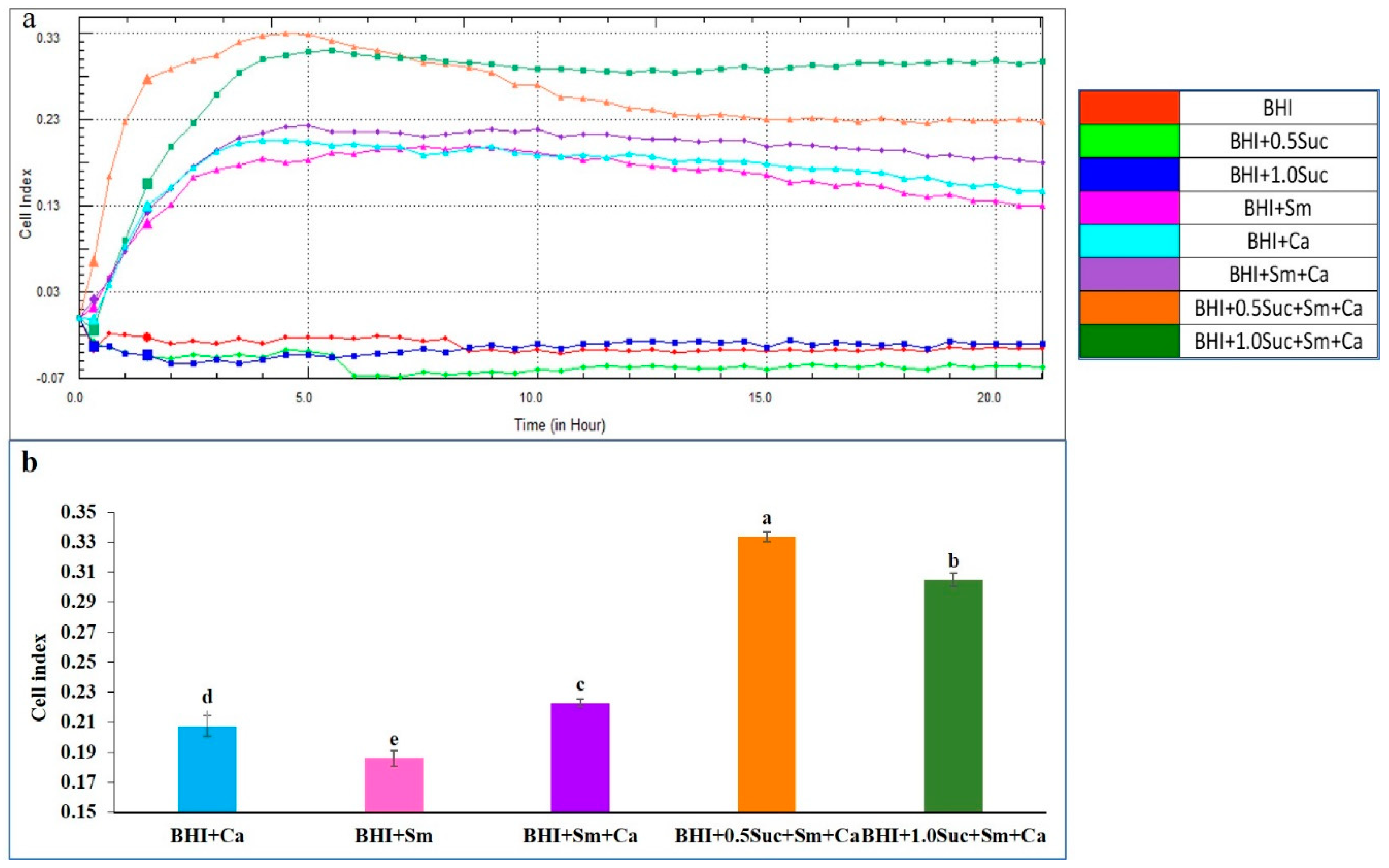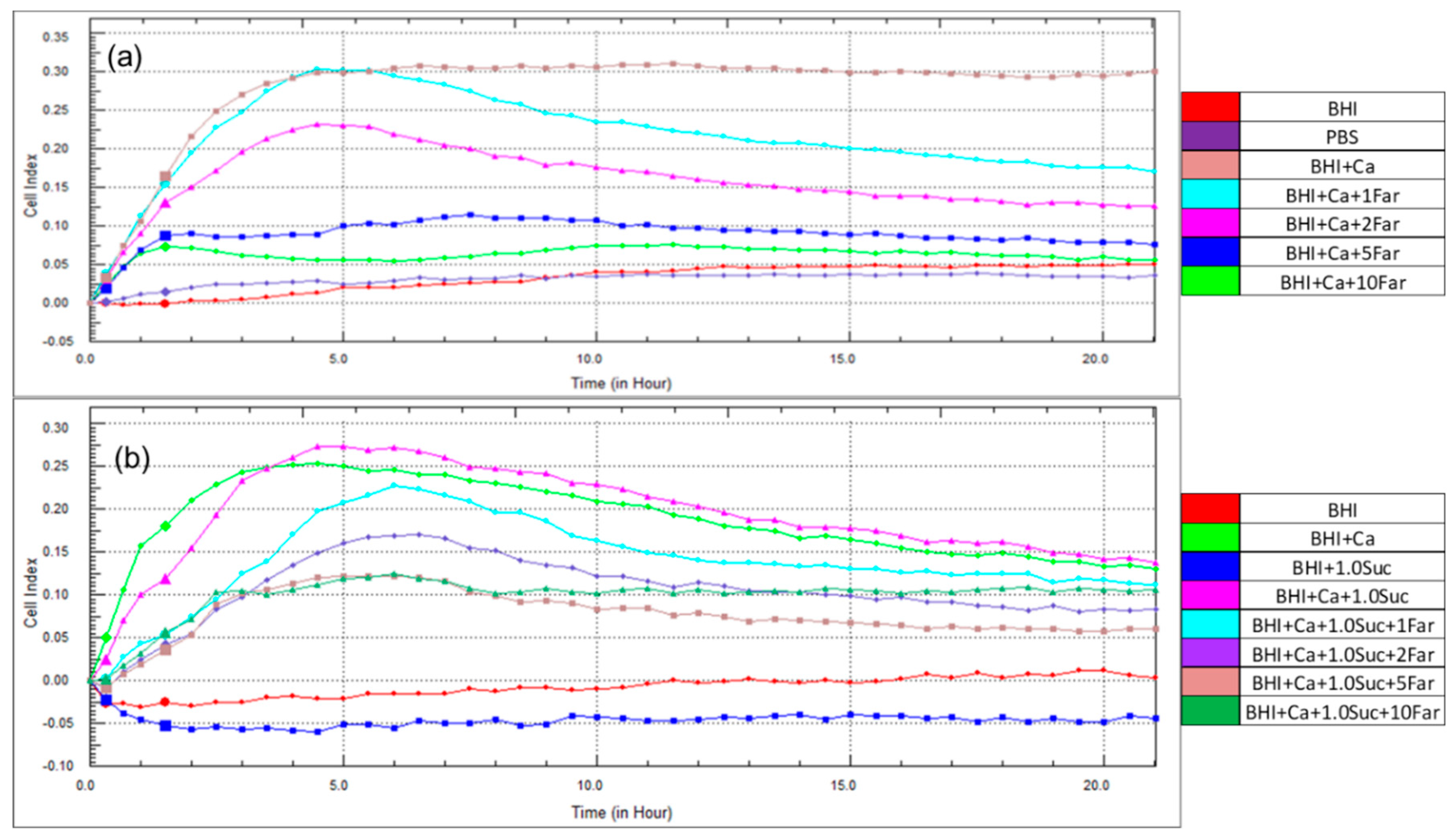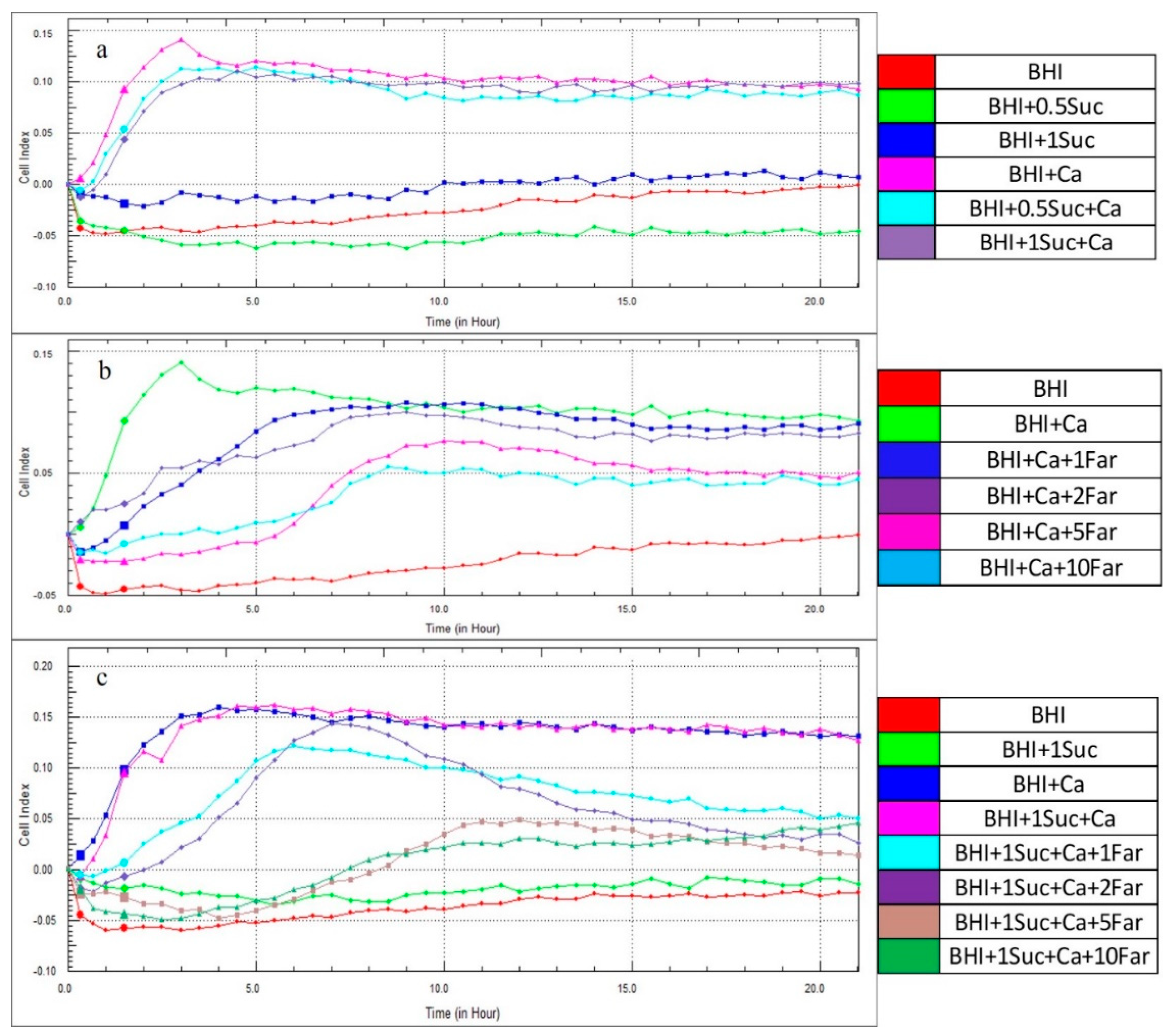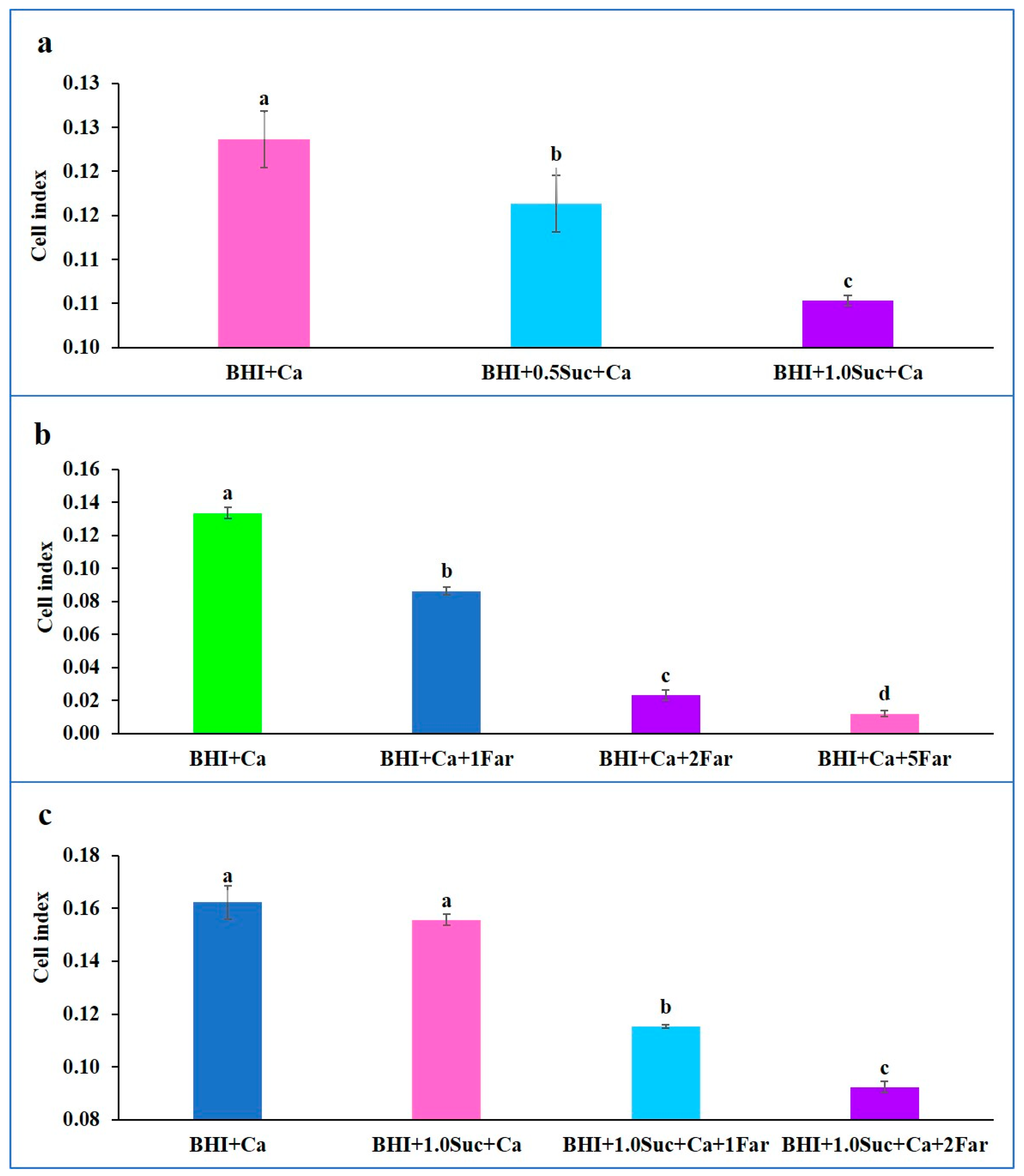Effects of Sucrose and Farnesol on Biofilm Formation by Streptococcus mutans and Candida albicans
Abstract
:1. Introduction
2. Materials and Methods
2.1. Preparation of Culture Media
2.2. Source of C. albicans and S. mutans and Culture Conditions
2.3. Preparation of C. albicans Hyphal Cells
2.4. Effect of Sucrose on CI Variation in C. albicans and S. mutans
- For S. mutans:
- 200 µL of BHI
- 200 µL of Phosphate-buffered saline (PBS)
- 200 µL of BHI with 0.5% sucrose
- 200 µL of BHI with 1.0% sucrose
- 100 µL of S. mutans and 100 µL of BHI
- 100 µL of S. mutans and 100 µL of BHI with 0.5% sucrose
- 100 µL of S. mutans and 100 µL of BHI with 1.0% sucrose
- For C. albicans (yeast cells):
- 200 µL of BHI
- 200 µL of BHI with 0.5% sucrose
- 200 µL of BHI with 1.0% sucrose
- 200 µL of BHI with 2.0% sucrose
- 100 µL of C. albicans and 100 µL of BHI
- 100 µL of C. albicans and 100 µL of BHI with 0.5% sucrose
- 100 µL of C. albicans and 100 µL of BHI with 1.0% sucrose
- 100 µL of C. albicans and 100 µL of BHI with 2.0% sucrose
2.5. Effect of Sucrose on CI Variation in Mixed Species of C. albicans and S. mutans
- 200 µL of BHI
- 200 µL of BHI with 0.5% sucrose
- 200 µL of BHI with 1.0% sucrose
- 100 µL of BHI with 100 µL of S. mutans
- 100 µL of BHI with 100 µL of C. albicans
- 100 µL of BHI with 50 µL of S. mutans + 50 µL of C. albicans
- 100 µL of BHI with 0.5% sucrose + 50 µL of S. mutans + 50 µL of C. albicans
- 100 µL of BHI with 1.0% sucrose + 50 µL of S. mutans + 50 µL of C. albicans
2.6. Effect of Farnesol on CI Variation in C. albicans (Yeast Cells)
- 200 µL of BHI
- 200 µL of PBS
- 100 µL of BHI + 100 µL of C. albicans
- 100 µL of BHI + 50 µL of C. albicans + 50 µL of 1.0 mM farnesol
- 100 µL of BHI + 50 µL of C. albicans + 50 µL of 2.0 mM farnesol
- 100 µL of BHI + 50 µL of C. albicans + 50 µL of 5.0 mM farnesol
- 100 µL of BHI + 50 µL of C. albicans + 50 µL of 10 mM farnesol
2.7. Combined Effect of Sucrose and Farnesol on CI Variation in C. albicans (Yeast Cells)
- 200 µL of BHI
- 200 µL of BHI + 1.0% sucrose
- 100 µL of BHI + 100 µL of C. albicans
- 100 µL of BHI + 1.0% sucrose + 100 µL of C. albicans
- 100 µL of BHI + 1.0% sucrose + 50 µL of C. albicans + 50 µL of 1.0 mM farnesol
- 100 µL of BHI + 1.0% sucrose + 50 µL of C. albicans + 50 µL of 2.0 mM farnesol
- 100 µL of BHI + 1.0% sucrose + 50 µL of C. albicans + 50 µL of 5.0 mM farnesol
- 100 µL of BHI + 1.0% sucrose + 50 µL of C. albicans + 50 µL of 10 mM farnesol
2.8. Individual and Combined Effects of Sucrose and Farnesol on CI Variation in the Hyphal Cells of C. albicans
2.9. Statistical Analysis
3. Results
3.1. Effects of Sucrose on Biofilm Formation by S. mutans and C. albicans Yeast Cells
3.2. Effect of Sucrose on Biofilm Formation by Mixed Cultures of S. mutans and C. albicans Yeast Cells
3.3. Effect of Farnesol Alone or in Combination with Sucrose on Biofilm Formation by C. albicans Yeast Cells
3.4. Individual and Combined Effects of Sucrose and Farnesol on Biofilm Formation by C. albicans Hyphal Cells
4. Discussion
5. Conclusions
Author Contributions
Funding
Data Availability Statement
Conflicts of Interest
References
- Dye, B.A.; Hsu, K.-L.C.; Afful, J. Prevalence and measurement of dental caries in young children. Pediatr. Dent. 2015, 37, 200–216. [Google Scholar] [PubMed]
- Ghazal, T.; Levy, S.M.; Childers, N.K.; Broffitt, B.; Cutter, G.; Wiener, H.W.; Kempf, M.; Warren, J.; Cavanaugh, J. Prevalence and incidence of early childhood caries among African-American children in Alabama. J. Public Health Dent. 2015, 75, 42–48. [Google Scholar] [CrossRef] [PubMed]
- Bottner, A.; He, R.Y.; Sarbu, A.; Nainar, S.M.H.; Dufour, D.; Gong, S.G.; Lévesque, C.M. Streptococcus mutans isolated from children with severe-early childhood caries form higher levels of persisters. Arch. Oral Biol. 2020, 110, 104601. [Google Scholar] [CrossRef]
- Childers, N.K.; Momeni, S.S.; Whiddon, J.; Cheon, K.; Cutter, G.R.; Wiener, H.W.; Ghazal, T.S.; Ruby, J.D.; Moser, S.A. Association between early childhood caries and colonization with Streptococcus mutans genotypes from mothers. Pediatr. Dent. 2017, 39, 130–135. [Google Scholar]
- Karp, J.; Berkowitz, R. Clinical outcomes for severe early childhood caries. Curr. Pediatr. Rev. 2008, 4, 169–173. [Google Scholar] [CrossRef]
- Palmer, C.A.; Kent, R.; Loo, C.Y.; Hughes, C.V.; Stutius, E.; Pradhan, N.; Dahlan, M.; Kanasi, E.; Arevalo Vasquez, S.S.; Tanner, A.C. Diet and caries-associated bacteria in severe early childhood caries. J. Dent. Res. 2010, 89, 1224–1229. [Google Scholar] [CrossRef]
- de Carvalho, F.G.; Silva, D.S.; Hebling, J.; Spolidorio, L.C.; Spolidorio, D.M.P. Presence of mutans streptococci and Candida spp. in dental plaque/dentine of carious teeth and early childhood caries. Arch. Oral Biol. 2006, 51, 1024–1028. [Google Scholar] [CrossRef]
- Raja, M.; Hannan, A.; Ali, K. Association of oral candidal carriage with dental caries in children. Caries Res. 2010, 44, 272–276. [Google Scholar] [CrossRef]
- Xiao, J.; Moon, Y.; Li, L.; Rustchenko, E.; Wakabayashi, H.; Zhao, X.; Feng, C.; Gill, S.R.; McLaren, S.; Malmstrom, H.; et al. Candida albicans carriage in children with severe early childhood caries (S-ECC) and maternal relatedness. PLoS ONE 2016, 11, e0164242. [Google Scholar] [CrossRef]
- Yang, X.Q.; Zhang, Q.; Lu, L.Y.; Yang, R.; Liu, Y.; Zou, J. Genotypic distribution of Candida albicans in dental biofilm of Chinese children associated with severe early childhood caries. Arch. Oral Biol. 2012, 57, 1048–1053. [Google Scholar] [CrossRef]
- Falsetta, M.L.; Klein, M.I.; Colonne, P.M.; Scott-Anne, K.; Gregoire, S.; Pai, C.-H.; Gonzalez-Begne, M.; Watson, G.; Krysan, D.J.; Bowen, W.H.; et al. Symbiotic relationship between Streptococcus mutans and Candida albicans synergizes virulence of plaque biofilms in vivo. Infect. Immun. 2014, 82, 1968–1981. [Google Scholar] [CrossRef] [PubMed]
- Alkhars, N.; Al Jallad, N.; Wu, T.T.; Xiao, J. Multilocus sequence typing of Candida albicans oral isolates reveals high genetic relatedness of mother-child dyads in early life. PLoS ONE 2024, 19, e0290938. [Google Scholar] [CrossRef]
- Inquimbert, C.; Bourgeois, D.; Bravo, M.; Viennot, S.; Tramini, P.; Llodra, J.C.; Molinari, N.; Dussart, C.; Giraudeau, N.; Carrouel, F. The oral bacterial microbiome of interdental surfaces in adolescents according to carious risk. Microorganisms 2019, 7, 319. [Google Scholar] [CrossRef] [PubMed]
- Newbrun, E. Sucrose, the arch criminal of dental caries. Odontol. Revy 1967, 18, 373–386. [Google Scholar]
- Bowen, W.H. Do We Need to Be Concerned about Dental Caries in the Coming Millennium? Crit. Rev. Oral Biol. Med. 2002, 13, 126–131. [Google Scholar] [CrossRef]
- Schilling, K.M.; Bowen, W.H. Glucans synthesized in situ in experimental salivary pellicle function as specific binding sites for Streptococcus mutans. Infect. Immun. 1992, 60, 284–295. [Google Scholar] [CrossRef]
- Vacca-Smith, A.M.; Bowen, W.H. Binding properties of streptococcal glucosyltransferases for hydroxyapatite, saliva-coated hydroxyapatite, and bacterial surfaces. Arch. Oral Biol. 1998, 43, 103–110. [Google Scholar] [CrossRef]
- Cai, J.-N.; Jung, J.-E.; Dang, M.-H.; Kim, M.-A.; Yi, H.-K.; Jeon, J.-G. Functional relationship between sucrose and a cariogenic biofilm formation. PLoS ONE 2016, 11, e0157184. [Google Scholar] [CrossRef]
- Duarte, S.; Klein, M.I.; Aires, C.P.; Cury, J.A.; Bowen, W.H.; Koo, H. Influences of starch and sucrose on Streptococcus mutans biofilms. Oral Microbiol. Immunol. 2008, 23, 206–212. [Google Scholar] [CrossRef] [PubMed]
- Nikawa, H.; Nishimura, H.; Hamada, T.; Kumagai, H.; Samaranayake, L.P. Effects of dietary sugars and, saliva and serum on Candida bioflim formation on acrylic surfaces. Mycopathologia 1997, 139, 87–91. [Google Scholar] [CrossRef]
- Pemmaraju, S.C.; Pruthi, P.A.; Prasad, R.; Pruthi, V. Modulation of Candida albicans biofilm by different carbon sources. Mycopathologia 2016, 181, 341–352. [Google Scholar] [CrossRef]
- Fernandes, R.A.; Monteiro, D.R.; Arias, L.S.; Fernandes, G.L.; Delbem, A.C.B.; Barbosa, D.B. Biofilm formation by Candida albicans and Streptococcus mutans in the presence of farnesol: A quantitative evaluation. Biofouling 2016, 32, 329–338. [Google Scholar] [CrossRef] [PubMed]
- Abrantes, P.M.D.S.; Africa, C.W.J. Measuring Streptococcus mutans, Streptococcus sanguinis and Candida albicans biofilm formation using a real-time impedance-based system. J. Microbiol. Methods 2020, 169, 105815. [Google Scholar] [CrossRef] [PubMed]
- Shin, D.S.; Eom, Y.B. Efficacy of zerumbone against dual-species biofilms of Candida albicans and Staphylococcus aureus. Microb. Pathog. 2019, 137, 103768. [Google Scholar] [CrossRef] [PubMed]
- Martins, M.; Henriques, M.; Azeredo, J.; Rocha, S.M.; Coimbra, M.A.; Oliveira, R. Morphogenesis control in Candida albicans and Candida dubliniensis through signaling molecules produced by planktonic and biofilm cells. Eukaryot. Cell 2007, 6, 2429–2436. [Google Scholar] [CrossRef]
- Fernandes, R.A.; Monteiro, D.R.; Arias, L.S.; Fernandes, G.L.; Delbem, A.C.B.; Barbosa, D.B. Virulence factors in Candida albicans and Streptococcus mutans biofilms mediated by farnesol. Indian J. Microbiol. 2018, 58, 138–145. [Google Scholar] [CrossRef]
- Jeon, J.-G.; Pandit, S.; Xiao, J.; Gregoire, S.; Falsetta, M.L.; Klein, M.I.; Koo, H. Influences of trans-trans farnesol, a membrane-targeting sesquiterpenoid, on Streptococcus mutans physiology and survival within mixed-species oral biofilms. Int. J. Oral Sci. 2011, 3, 98–106. [Google Scholar] [CrossRef]
- Sudbery, P.E. Growth of Candida albicans hyphae. Nat. Rev. Microbiol. 2011, 9, 737–748. [Google Scholar] [CrossRef]
- Chandra, J.; Kuhn, D.M.; Mukherjee, P.K.; Hoyer, L.L.; McCormick, T.; Ghannoum, M.A. Biofilm formation by the fungal pathogen Candida albicans: Development, architecture, and drug resistance. J. Bacteriol. 2001, 183, 5385–5394. [Google Scholar] [CrossRef]
- Finkel, J.S.; Mitchell, A.P. Genetic control of Candida albicans biofilm development. Nat. Rev. Microbiol. 2011, 9, 109–118. [Google Scholar] [CrossRef]
- Gow, N.A.R.; van de Veerdonk, F.L.; Brown, A.J.P.; Netea, M.G. Candida albicans morphogenesis and host defence: Discriminating invasion from colonization. Nat. Rev. Microbiol. 2011, 10, 112–122. [Google Scholar] [CrossRef]
- Ramage, G.; Saville, S.P.; Thomas, D.P.; López-Ribot, J.L. Candida biofilms: An update. Eukaryot. Cell 2005, 4, 633–638. [Google Scholar] [CrossRef] [PubMed]
- Saville, S.P.; Lazzell, A.L.; Monteagudo, C.; Lopez-Ribot, J.L. Engineered control of cell morphology in vivo reveals distinct roles for yeast and filamentous forms of Candida albicans during infection. Eukaryot. Cell 2003, 2, 1053–1060. [Google Scholar] [CrossRef]
- Hench, L.L. Biomaterials: A forecast for the future. Biomaterials 1998, 19, 1419–1423. [Google Scholar] [CrossRef]
- Atriwal, T.; Azeem, K.; Husain, F.M.; Hussain, A.; Khan, M.N.; Alajmi, M.F.; Abid, M. Mechanistic understanding of Candida albicans biofilm formation and approaches for its inhibition. Front. Microbiol. 2021, 12, 638609. [Google Scholar] [CrossRef]
- Jin, Y.; Samaranayake, L.P.; Samaranayake, Y.; Yip, H.K. Biofilm formation of Candida albicans is variably affected by saliva and dietary sugars. Arch. Oral Biol. 2004, 49, 789–798. [Google Scholar] [CrossRef] [PubMed]
- Junka, A.F.; Janczura, A.; Smutnicka, D.; Mączyńska, B.; Anna, S.; Nowicka, J.; Bartoszewicz, M.; Gościniak, G. Use of the real time xCelligence system for purposes of medical microbiology. Pol. J. Microbiol. 2012, 61, 191–197. [Google Scholar] [CrossRef] [PubMed]
- Van Duuren, J.B.J.H.; Müsken, M.; Karge, B.; Tomasch, J.; Wittmann, C.; Häussler, S.; Brönstrup, M. Use of single-frequency impedance spectroscopy to characterize the growth dynamics of biofilm formation in Pseudomonas aeruginosa. Sci. Rep. 2017, 1, 5223. [Google Scholar] [CrossRef]
- Ferrer, M.D.; Rodriguez, J.C.; Álvarez, L.; Artacho, A.; Royo, G.; Mira, A. Effect of antibiotics on biofilm inhibition and induction measured by real-time cell analysis. J. Appl. Microbiol. 2017, 122, 640–650. [Google Scholar] [CrossRef] [PubMed]
- Parisotto, T.M.; Steiner-Oliveira, C.; Silva, C.M.; Rodrigues, L.K.; Nobre-dos-Santos, M. Early childhood caries and mutans streptococci: A systematic review. Oral Health Prev. Dent. 2010, 8, 59–70. [Google Scholar]
- Cai, J.N.; Choi, H.M.; Jeon, J.G. Relationship between sucrose concentration and bacteria proportion in a multispecies biofilm: Short title: Sucrose challenges to a multispecies biofilm. J. Oral Microbiol. 2021, 13, 1910443. [Google Scholar] [CrossRef] [PubMed]
- Waldman, L.J.; Butera, T.; Boyd, J.D.; Grady, M.E. Sucrose-mediated formation and adhesion strength of Streptococcus mutans biofilms on titanium. Biofilm 2023, 6, 100143. [Google Scholar] [CrossRef]
- Gutiérrez, D.; Hidalgo-Cantabrana, C.; Rodríguez, A.; García, P.; Ruas-Madiedo, P. Monitoring in real time the formation and removal of biofilms from clinical related pathogens using an impedance-based technology. PLoS ONE 2016, 11, e0163966. [Google Scholar] [CrossRef] [PubMed]
- Assaf, D.; Steinberg, D.; Shemesh, M. Lactose triggers biofilm formation by Streptococcus mutans. Int. Dairy J. 2015, 42, 51–57. [Google Scholar] [CrossRef]
- Oliveira, D.; Rosa Virginia Dutra, Y.E.A.; Spolidorio, D.M.P.; Koga-Ito, C.Y.; Brighenti, F.L. Influence of different fermentable carbohydrates on dual-species biofilms of S. mutans and A. naeslundii—A pilot study. Braz. Dent. Sci. 2015, 18, 82–88. [Google Scholar] [CrossRef]
- Leal, C.R.L.; Alvarenga, L.H.; Oliveira-Silva, T.; Kato, I.T.; Godoy-Miranda, B.; Bussadori, S.K.; Ribeiro, M.S.; Prates, R.A. Antimicrobial photodynamic therapy on Streptococcus mutans is altered by glucose in the presence of methylene blue and red LED. Photodiagn. Photodyn. Ther. 2017, 19, 1–4. [Google Scholar] [CrossRef]
- Pang, L.; Zhi, Q.; Jian, W.; Liu, Z.; Lin, H. The oral microbiome impacts the link between sugar consumption and caries: A preliminary study. Nutrients 2022, 14, 3693. [Google Scholar] [CrossRef] [PubMed]
- Vitiello, F.; Bourgeois, D.; Orilisi, G.; Orsini, G.; Carrouel, F. Non-Cariogenic Effect of Milk and Dairy Products on Oral Health in Children and Adolescents: A Scoping Review. Children 2024, 11, 149. [Google Scholar] [CrossRef]
- Bourgeois, D.; Bravo, M.; Llodra, J.C.; Inquimbert, C.; Viennot, S.; Dussart, C.; Carrouel, F. Calibrated interdental brushing for the prevention of periodontal pathogens infection in young adults-a randomized controlled clinical trial. Sci. Rep. 2019, 9, 15127. [Google Scholar] [CrossRef]
- Miranda, D.G.; Ramos, L.D.; Attik, N.; Pereira, T.C.; Oliveira, L.D.; Marcucci, M.C.; Rodrigues, F.P.; Back Brito, G.N.; Carrouel, F. Pfaffia paniculata Extract, a Potential Antimicrobial Agent against Candida spp., Pseudomonas aeruginosa, and Streptococcus mutans Biofilms. Microorganisms 2024, 12, 1165. [Google Scholar] [CrossRef]
- Tabassum, N.; Khan, F.; Kang, M.G.; Jo, D.M.; Cho, K.J.; Kim, Y.M. Inhibition of polymicrobial biofilms of Candida albicans–Staphylococcus aureus/Streptococcus mutans by fucoidan–gold nanoparticles. Mar. Drugs 2023, 21, 123. [Google Scholar] [CrossRef] [PubMed]
- Hosida, T.Y.; Pessan, J.P.; Cavazana, T.P.; Sampaio, C.; de Morais, L.A.; Monteiro, D.R.; Delbem, A.C. Effects of sodium hexametaphosphate and fluoride on the ph and inorganic components of Streptococcus mutans and Candida albicans biofilm after sucrose exposure. Antibiotics 2022, 11, 1044. [Google Scholar] [CrossRef] [PubMed]
- Gaálová-Radochová, B.; Kendra, S.; Jordao, L.; Kursawe, L.; Kikhney, J.; Moter, A.; Bujdáková, H. Effect of quorum sensing molecule farnesol on mixed biofilms of Candida albicans and Staphylococcus aureus. Antibiotics 2023, 12, 441. [Google Scholar] [CrossRef]







Disclaimer/Publisher’s Note: The statements, opinions and data contained in all publications are solely those of the individual author(s) and contributor(s) and not of MDPI and/or the editor(s). MDPI and/or the editor(s) disclaim responsibility for any injury to people or property resulting from any ideas, methods, instructions or products referred to in the content. |
© 2024 by the authors. Licensee MDPI, Basel, Switzerland. This article is an open access article distributed under the terms and conditions of the Creative Commons Attribution (CC BY) license (https://creativecommons.org/licenses/by/4.0/).
Share and Cite
Wint, W.Y.; Miyanohara, M.; Terada-Ito, C.; Yamada, H.; Ryo, K.; Murata, T. Effects of Sucrose and Farnesol on Biofilm Formation by Streptococcus mutans and Candida albicans. Microorganisms 2024, 12, 1737. https://doi.org/10.3390/microorganisms12081737
Wint WY, Miyanohara M, Terada-Ito C, Yamada H, Ryo K, Murata T. Effects of Sucrose and Farnesol on Biofilm Formation by Streptococcus mutans and Candida albicans. Microorganisms. 2024; 12(8):1737. https://doi.org/10.3390/microorganisms12081737
Chicago/Turabian StyleWint, Wit Yee, Mayu Miyanohara, Chika Terada-Ito, Hidenori Yamada, Koufuchi Ryo, and Takatoshi Murata. 2024. "Effects of Sucrose and Farnesol on Biofilm Formation by Streptococcus mutans and Candida albicans" Microorganisms 12, no. 8: 1737. https://doi.org/10.3390/microorganisms12081737





